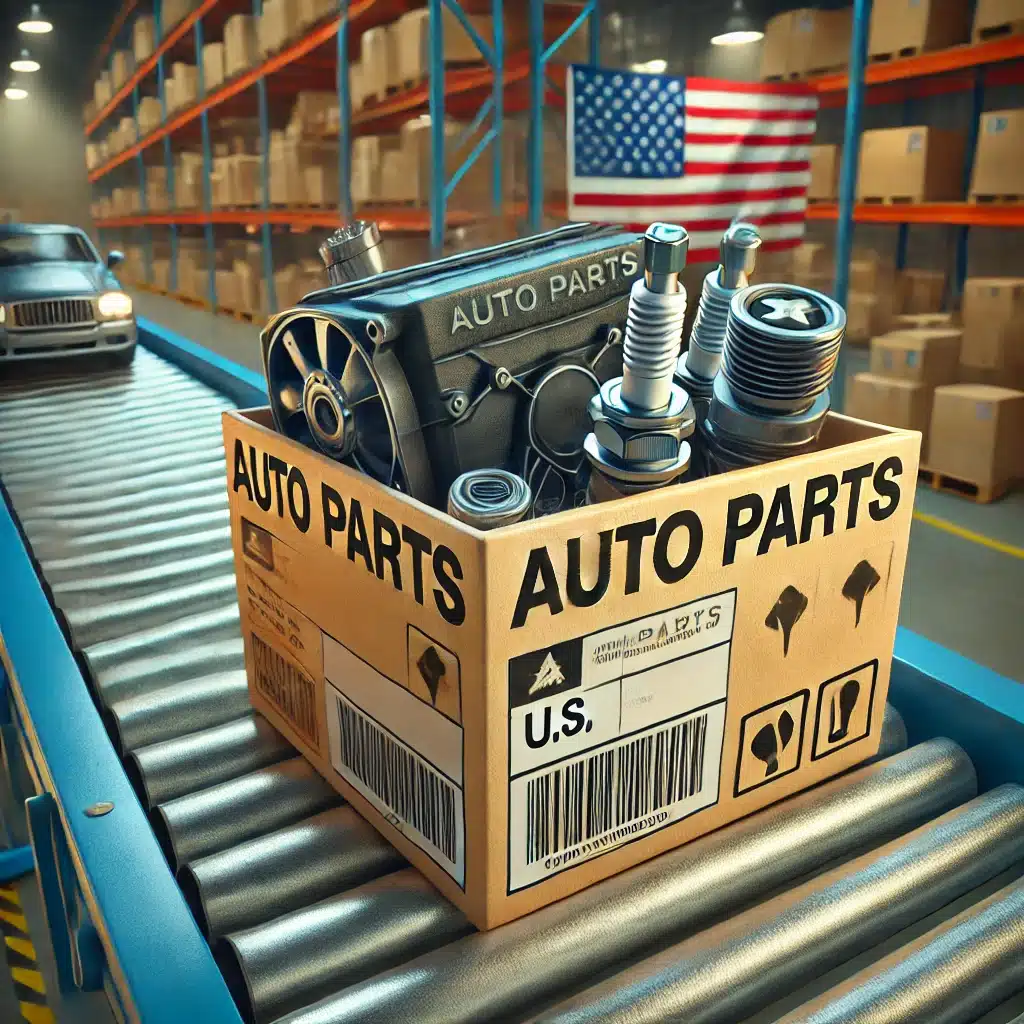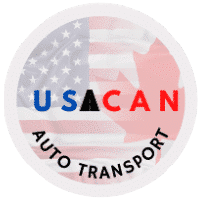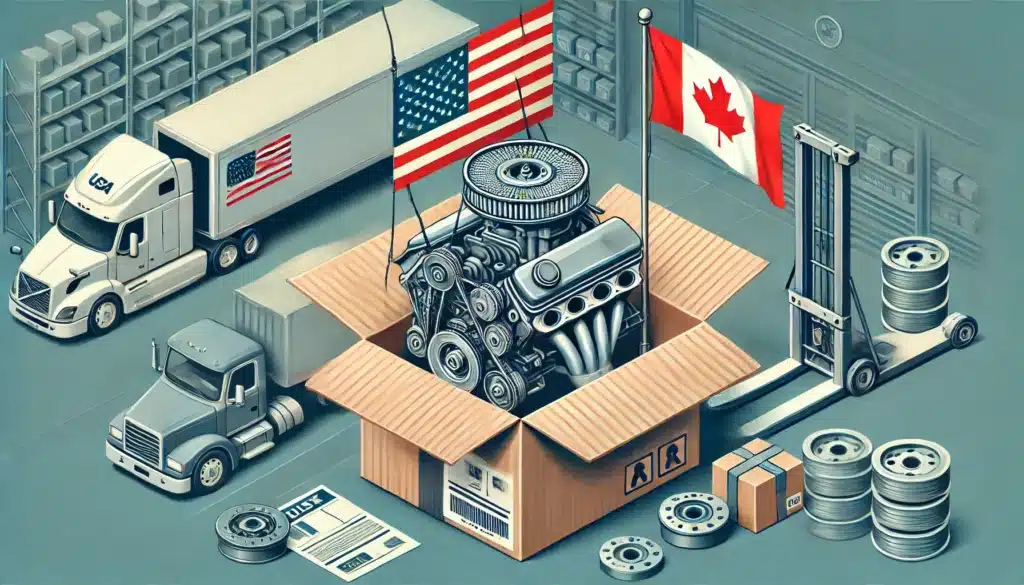The automotive trade between the United States and Canada is a cornerstone of their economic relationship. It is characterized by the substantial cross-border exchange of vehicles and automotive parts. This integration is the reason why there are so many people in Canada looking at how to ship car parts from the US.
It’s fairly common for parts to be manufactured in Canada and be assembled in the U.S, or the other way round. In fact, parts may cross the border a number of times before being used on a vehicle. Below is a table summarizing the key trade figures for the U.S and Canadian automotive industries for the year 2022:
| Trade Flow | Category | Value (USD) | Percentage of Total Trade |
|---|---|---|---|
| U.S. Exports to Canada | Vehicles and Parts | $51.8 billion | 39% |
| U.S. Imports from Canada | Vehicles and Parts | $45.4 billion | 61% |
Automotive Trade is fairly balanced between the 2 countries
The following are the major characteristics of trade between the 2 countries;
- Mutual Dependence: Both nations rely heavily on each other for automotive trade, with a balanced exchange of vehicles and parts. With so much trade happening between the two countries’ automotive industries, it’s inevitable that people are going to look for auto parts across the border.
- Trade Balance: The trade figures indicate a closely matched import-export relationship, reflecting integrated supply chains and collaborative manufacturing processes. This issue has recently come to the fore, amidst threats by President Trump to impose tariffs on Canada. It’s clear, at least based on figures from 2022, that the U.S holds a slight edge when it comes to the balance of trade for automotive parts. It exports more to Canada than it imports.
Why ship car parts from the US to Canada
Before we learn how to ship car parts from the US to Canada, we first need to take a look at why you would seek to do so in the first place. Isn’t it better to look for car parts in Canada? Shipping car parts from the USA to Canada is a common need for car enthusiasts, mechanics, and businesses looking to access a broader range of parts.
Several factors contribute to this trend, making cross-border shipping an attractive option for car owners, mechanics, and automotive enthusiasts. Here are some of the main reasons why people choose to import auto parts from the U.S. into Canada.
1. Greater Availability of Parts
Many specialized or rare auto parts are more readily available in the U.S. than in Canada. Whether it’s aftermarket performance upgrades, vintage car components, or OEM parts for newer vehicles, U.S. retailers and manufacturers often have a larger selection than their Canadian counterparts.
2. Lower Prices
Auto parts in the U.S. are often cheaper due to a more competitive market, lower taxes, and larger economies of scale. Even when factoring in shipping costs and import duties, many Canadians find that buying from the U.S. still results in overall savings.
This is something that you can easily verify yourself. In fact, even cars tend to be cheaper in the U.S than in Canada on average. It’s the reason why there are so many people buying their vehicles north of the border. Even when factoring in shipping costs from the U.S to Canada, importing may still be ideal.
3. Faster Access to New Products
New automotive technologies, accessories, and performance parts are frequently released in the U.S. market before becoming widely available in Canada. Importing directly from the U.S. allows Canadian buyers to access the latest parts without long delays.
4. Better Quality and Selection
Many American aftermarket manufacturers and brands offer superior quality auto parts compared to those available in Canada. At least that’s the belief among some Canadians. That could be the reason why you have set out to learn how to ship car parts from the US to Canada.
U.S. retailers also provide a wider variety of brands and options, allowing customers to choose the best fit for their needs. Again, this may be a matter of perception. We have already noted that the US and Canadian automotive industries are highly integrated.
5. Limited Local Stock and Dealer Markups
Some auto parts are difficult to find in Canada due to limited local stock. This ties into what we have already mentioned in some of the above points.
Even when available, Canadian dealerships and auto shops often apply significant markups. Ordering directly from U.S. suppliers can help consumers avoid inflated prices.
6. Convenient Shipping and Freight Forwarding Options
With numerous shipping methods available—courier services, freight forwarders, and package consolidation—getting auto parts from the U.S. to Canada has never been easier. Many suppliers also offer hassle-free international shipping and customs clearance assistance.
For those looking to ship auto parts from the U.S to Canada, we, at US Canada Auto Transport, can facilitate the importation of auto parts from the U.S to Canada in as seamless a way as is possible.
We have been in business since 1985, making us one of the biggest companies in the business. That has given us the knowledge that is required to easily navigate the often hectic auto parts importation process.
We work with several reputable freight forwarding companies, thus ensuring that the precious car parts that you are shipping arrive at their destination on time and in good condition.
Where to Buy Auto Parts from the U.S. When You’re in Canada
This article shows you how to buy ship auto parts from the US to Canada. But before you can do that, you need to first buy the parts in question. If you’re in Canada and need auto parts that are either unavailable or more expensive locally, buying from the U.S. can be a great option. Here’s how and where you can get the best deals while navigating shipping and customs.
Buying options
- Online Retailers – Websites like RockAuto, AutoZone, Summit Racing, and CarParts.com offer a vast selection of parts at competitive prices. These are the platforms that most people use. The advantage is that you don’t have to visit the United States to get the parts that you are looking for. The disadvantage is that shipping costs tend to be rather high, particular if the parts that you are buying are heavy.
- eBay & Amazon – Many U.S. sellers on these platforms ship to Canada, but check seller ratings and shipping policies. Again, the issue of high shipping options may arise.
- Manufacturer Websites – If you’re looking for OEM parts, check the official websites of brands like Ford, GM, Toyota, or Mopar. The advantage of buying from them is that you can be assured that you are getting original parts.
- Salvage Yards & Junkyards – Websites like Car-Part.com can help you find used parts from U.S. salvage yards that may ship to Canada. Buying from a salvage yard can be a challenge in terms of quality assurance. That’s particularly the case if you do so without inspecting the part in question.
How to ship your car parts to Canada from the US

Now that you have found and bought the parts that you were looking, it’s time for you to ship them to Canada from the United States. So, how do you do that? We outline the available options in the section below;
1. Courier Services (FedEx, UPS, DHL, Purolator)
Courier services offer a fast and reliable way to ship car parts across the border. These companies provide door-to-door service with real-time tracking, making them ideal for valuable or time-sensitive shipments.
- Advantages: Fast delivery, tracking, customs clearance assistance
- Disadvantages: Higher shipping costs, possible brokerage fees
- Cost Estimate: $50-$500 depending on size, weight, and service level
- Delivery Time: 1-7 business days
2. USPS (United States Postal Service) and Canada Post
For smaller and less urgent shipments, USPS is an affordable alternative. Canada Post handles the delivery once it arrives in Canada.
- Advantages: Lower shipping costs, fewer brokerage fees
- Disadvantages: Slower transit times, limited tracking on some services
- Cost Estimate: $20-$150, depending on weight and size
- Delivery Time: 7-14 business days
3. Freight Shipping (LTL & Full Truckload)
For large and heavy parts such as engines, transmissions, or body panels, Less-than-Truckload (LTL) and Full Truckload (FTL) freight services are the best options. Companies like FedEx Freight, Old Dominion, and YRC Freight specialize in this type of shipping.
- Advantages: Cost-effective for large shipments, suitable for heavy parts
- Disadvantages: Longer delivery times, requires additional paperwork
- Cost Estimate: $200-$2,000 depending on size and distance
- Delivery Time: 5-14 business days
4. Cross-Border Freight Forwarders
Freight forwarders such as MyUS, Shipito, or CrossBorder Pickups consolidate shipments from the US and transport them to Canada efficiently. This is a great option if you need multiple parts from different US suppliers.
- Advantages: Lower shipping costs, easier customs clearance, consolidation available
- Disadvantages: Additional handling time, may require a pickup
- Cost Estimate: $50-$500, varies by weight and dimensions
- Delivery Time: 5-10 business days
5. Personal Pickup & Third-Party Drop-Off Locations
Some buyers choose to have their parts shipped to a US address near the border (e.g., a UPS Store in Buffalo, NY or a warehouse in Detroit, MI) and then pick them up personally or hire a third-party service to bring them across.
- Advantages: Avoid high shipping fees, control over customs declarations
- Disadvantages: Requires travel to the US, potential border delays
- Cost Estimate: $0-$100 (depending on distance and third-party fees)
- Delivery Time: Instant upon pickup
Customs and Import Considerations
One of the major challenge when it comes to buying car parts in another country is that one is subjected to duties and other import charges;
Duties and Taxes
Canada imposes import duties and taxes on car parts, depending on their classification:
- GST/HST: Generally 5-15%, depending on the province
- Duties: 0-10%, depending on the country of origin (parts made in the USA under USMCA may be duty-free)
- Brokerage Fees: Courier services may charge $10-$50 for customs processing
Required Documentation
To ensure smooth customs clearance, be sure to provide:
- Invoice/receipt from the seller
- Description of the parts
- Country of origin (needed for duty assessment)
- Proof of payment
Cost Breakdown Example
Here’s a rough estimate of what it may cost to ship a car part from the USA to Canada:
| Part Type | Shipping Method | Estimated Cost | Delivery Time |
|---|---|---|---|
| Small parts (filters, sensors) | USPS/Canada Post | $20-$50 | 7-14 days |
| Medium parts (brake rotors, alternators) | Courier (FedEx/UPS) | $50-$200 | 3-7 days |
| Large parts (transmissions, engines) | Freight Shipping | $200-$2,000 | 5-14 days |
| Multiple parts (bulk order) | Freight Forwarder | $100-$500 | 5-10 days |
Tips for Reducing Costs and Delays
- Compare Shipping Rates: Use tools like ShipNerd, Easyship, or Parcel Monkey to compare different carriers.
- Use USMCA Benefits: If the parts are made in the USA, ensure proper documentation to avoid duties.
- Consolidate Shipments: If ordering multiple parts, consolidate them to save on shipping.
- Check for Local Pickup Options: Some US retailers have Canadian warehouses, eliminating the need for cross-border shipping.
It can be cheaper to buy car parts in the US
We will close this post by reiterating that it is sometimes cheaper to buy auto parts in the US, for shipping to Canada. What you need to do is to carry out proper research to ensure that the savings that you wish to make are indeed available. In some cases, people are forced to look for parts abroad due to unavailability at home.
Shipping car parts from the USA to Canada can be straightforward if you understand the available options, costs, and timelines. Whether you choose a courier, postal service, freight shipping, or a freight forwarder, selecting the right method depends on the size, urgency, and budget of your shipment. By planning ahead and factoring in customs fees, you can ensure a hassle-free experience. Happy shipping!
If you have to go and look for car parts in the US, you will need to read our guide to US healthcare for Canadians.

